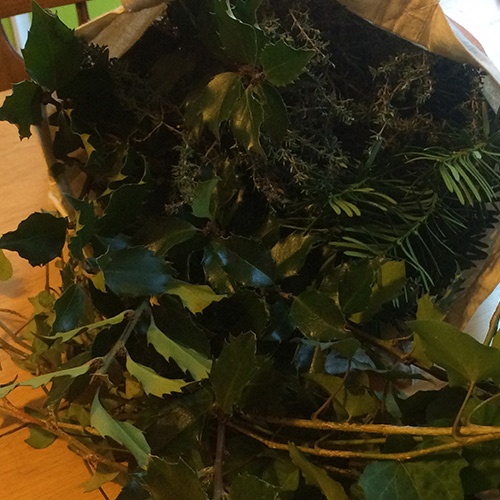 It is the day after Thanksgiving and leaving the books and the warmth of my living room, I step out into the pure chill of the late November afternoon. It is time for me to gather—and make—decorative garlands for the Advent season.
It is the day after Thanksgiving and leaving the books and the warmth of my living room, I step out into the pure chill of the late November afternoon. It is time for me to gather—and make—decorative garlands for the Advent season.
I turn the corner and walk past a line of houses: unmoving, silent, still. Though this urban landscape is not a desert or a steppe or a parched land, it is still a land waiting. Waiting for the sun and the rain and God to give God’s benefits. It is waiting to bloom, to yield its increase.
I open the gate of my community garden and walk to my plot. It rests beneath a swath of leaves, insulated and waiting for the next growing season. Yet—my English lavender and German thyme rise from the ground, their blue-green foliage contrasting with the red-brown leaves. I snip off a few of their branches. There is English ivy and holly and a pine nearby. I collect some of their greenness, too.
Back in my apartment, I lay out the various vegetation I’ve collected on the kitchen table. I measure out my jute twine and begin to attach bunches of leaves around its slim body with florist’s wire. As my garland gets longer, I let it dangle over the table edge. The garland begins to lower to the floor as my work continues, reminding me of the paralyzed man seeking Jesus’s healing in Luke 5. In order to get him close to Jesus, his friends lowered his body— silent, unmoving, still—on a stretcher through the roof. Jesus then bid him to rise and he did, picking up his stretcher and glorifying God.
I close my eyes and breath in. The piney scent, supported by the sweet smell of lavender and the peppery fragrance of thyme enters me. It is 40-odd degrees out and my garden sleeps under red-brown leaves. Still, God bids these evergreens to rise and rejoice. Like the crowd who saw the paralyzed man pick up his stretcher and walk, I “have seen incredible things today.”

 Sarah Woodford '10 M.Div.
Sarah Woodford '10 M.Div.


